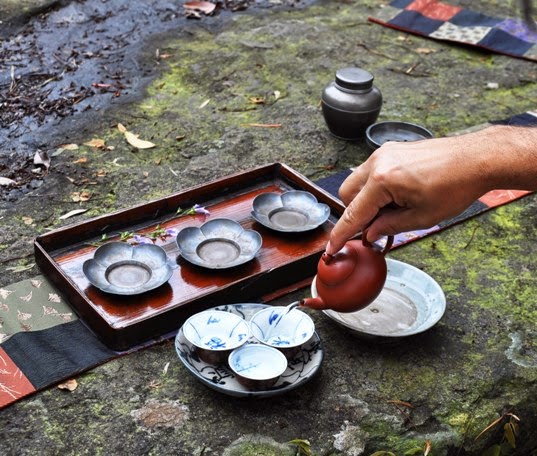Monday, May 19, 2014
Chaozhou gongfucha brewing, step by step
The Chaozhou Gongfu Cha brewing method originated during the Qing dynasty (1644-1911) in the eastern Guangdong province, next to Fujian. The tea used was roasted Oolong, preferably from the Wuyi mountains.
Chaozhou Gongfucha was necessarily brewed for 3 persons (like bridge is played by 4 people). If more people wanted to drink tea, they'd have to set up their own set (for another group of 3 people)... This method has greatly influenced the way tea is currently brewed in Taiwan and China. In a previous article, I have presented each item of the Gongfu cha set. Let's see how to use it!
First, water was boiled in a clay kettle (diao), heated by glowing hot charcoal in a Nilu.
This hot water is then poured on the zhuni teapot and then inside it and also also in the bowl (Chaxi):
This hot water in the bowl is used to preheat and wash the teacups. Using 2 fingers, the brewer turns the cup(s) in the hot water behind the teapot
The third cup is handled alone. What's important when handling all the cups is to only touch the outside walls of the cups. Touching or holding the cup's inside would be seen as a mistake, since the goal is to clean the cup.
The hot water inside the teapot is emptied in the cups. That's when you see if you have a good fit between the size of your teapot and the size of your cups:
The empty teapot floats on the water in the bowl if it is light enough and a real Shuiping (water balanced)! This is where this teapot quality came into play. The lid either rests on the Jianshui (waste water bowl) or on the cups. The dry leaves were stored in the pewter caddy and we put them now in the teapot with our hand, in the middle of the teapot. In case of Wuyi Yancha, we would first crush 30% of the leaves and then add 70% of whole leaves on top in order to produce a very strong brew:
The boiling water is poured onto the leaves:
No rinsing. The tea was top quality. While the leaves brew, the water is emptied in the Jianshui.
As I prepare to pour, I slowly let my teapot glide over the rim of the Chaxi in order to leave any water inside the bowl. It's also possible to use a piece of fabric to let the teapot rest a couple of seconds to dry its bottom:
The tea is poured in the cups: 1, 2, 3, 2, 1 in order to make the brew even:
The cups are placed on their pewter saucers:
The tea is then presented to the guests on a tray (cha pan):
The guests drink their cup of tea in three sips at least (not in 1!), because they wish to enjoy the taste rather than just drink to quench their thirst. (品 means tasting and this Chinese character is composed of 3 mouths).
For this Chaozhou Gongfucha demonstration, I've used my winter Shan Lin Shi strongly roasted Hungshui Oolong. Fittingly, the sun came out as we were enjoying this tea and shone its bright and warming light!
Subscribe to:
Post Comments (Atom)





















8 comments:
Beautiful!
really this amazing...and first of all useful. tea signify quality, pleasure and knowledge.
I've learned a lot with this post.
Thanks for your comments. I'm glad you find this interesting.
Je continue mon exploration du blog et je me régale, les articles s'enchaîne et le savoir afflue... serait-il possible de voir apparaître une vidéo sur le Chaozhou gongfu tel qu'il est présenté ici ?
Merci pour ta lecture, Greg.
Je n'ai pas de telle vidéo dans mes archives. J'essairai d'en faire à l'occasion.
Merci pour ta lecture, Greg.
Je n'ai pas de telle vidéo dans mes archives. J'essairai d'en faire à l'occasion.
So happy to find this! I first saw a similar presentation at an in person class in 2019 by Mary Cotterman who practiced making tea pots in ChaoZhou for three years. I am still trying to learn how to clean the cups without burning my fingers!
Post a Comment